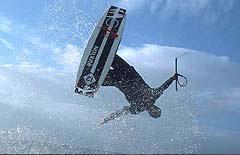
KM: Tell us about REAL kiteboarding and why you got involved.
TF: My partner Matt Nuzzo and I saw a serious hole in the industry. There was a lot of hype and excitement about the sport, more than enough kite and board manufacturers, but very few effiicient channels for people to enter the sport. Kiteboarding doesn’t fit the “retail model” where you can put it on a store shelf and it will sell. We know that kiteboarding has the potential to be a huge sport, but in order for it to achieve growth of that level, your average guy living in Boston or New York needed a one stop access avenue to learn the sport and how to safely operate the equipment. Our goal from the begining has been to be the link between the two: The gear and the potential customer.
KM: The other day on the phone you said you “wanted to make school cool”. What’s that all about?
TF: I think everyone agrees that you need to take lessons in order to learn kiteboarding safely and quickly. The problem that we saw was that customers were being told “they have to take lessons”. Nobody wants to “have to” do anything. Schools in the past from sports I was involved in were normally pretty dry and did a poor job marketing themselves. Our vision was to have a school that people wanted to come to. Our programs, our coaches, our locations and our events are all created around making the school fun and yes, “cool”.
KM: Tell us about some of the programs you’ve developed at REAL.
TF: The first was Kite Camps. We started doing these in the spring of 2000. Regular lessons are good, but most students need more time using the equipment in order to fully understand it. Learning to kiteboard is the easy part. Most people can get up on the board almost instantly. It’s the gear that troubles most people. This is why we started developing the camp system. Our camps cover everything the student needs to know all the way to gear repair and maintenance. They’re three full days and this gives them enough time using the equipment with coaches at hand for them to fully understand it and become self sufficient. The camp atmosphere is also a very fun and social one. We get people from all over the world who end up becoming friends and sharing experiences. They also learn from each others mistakes at the camp, which speeds the learning process.
After that, we developed “On the Fly”, which is a coaching method using PWC’s so that the coach is always with the student. “On the Fly” is not just simply using a waverunner for teaching, we’ve been doing that since 1998. On the Fly is a full teaching and water safety program for the coach to utilize from the jetski when working with the student. I started developing the program and Llew Simmonds put the finishing touches on it. We credit it as being one of the biggest reasons our students learn so fast.
KM: People are starting to recognize Cape Hatteras as one of the best places to kiteboard in the world. How’d you end up there?
TF: I moved there for windsurfing in 1992. It was just pure coincidence that it is such a good place for kiteboarding. Hatteras rules for riding. The sound is like a huge practice pool. 35 miles in every direction of waist deep, flat water. Beginners all the way to experts freak out when they see it. Plus the waves are great on the ocean side. Because of the bends in the island, we’ve got sideshore conditions for every wind direction. I love it here. I couldn’t imagine living anywhere else.
KM: What kind of gear are you using?
TF: All of our school and camp gear is the latest kites and boards. Right now we have 2002 Wipika Kites, they had the insight to see the benefits of our programs and get fully behind them. We use their school dedicated NSK’s for our beginners and then Free Airs and Hydros for our intermediate and advanced students. We also have a coach on each of the other major brands (Naish, Slingshot, Liquid Force, North, Cabrinha, etc) so that we are knowledgeable on how that brand should be rigged and tuned for when students bring their own gear.
KM: Last year you were one of the first riders to promote the snow as a new venue. What does the future hold for snow kiteboarding?
TF: I think it has the potential to get bigger than the water side of the sport. There’s just more rideable snow than accessible water. Plus there’s less sporting options in the winter. Tell me five things you can do on a snow covered farmfield in Michigan. I got fully hooked last season. I got to ride over 40 days in Vermont, New Hampshire, New York, Ohio, Indiana, and Michigan. I didn’t buy one lift ticket and canceled my heli-trip. I got so much powder I didn’t need it. We’ve put a lot of effort into developing snow teaching programs as well. Matt’s been in Colorado this winter and has our lesson and camp systems rocking in the snow. I was supposed to be in Vermont, but the weather was so warm that the lake never froze and the snow didn’t fall. I guess that’s the beauty of having an east and west location! We just sent all the coaches to Colorado where the snow was good. I just saw some new pics of matt sliding rails and park benches all while being towed by a kite through a soccer field.
KM: You were just in Puerto Rico working on a new video. How’d that go?
TF: It was a fun trip. The wind blew everyday but one for three weeks straight. “Shot Masters” is an instructional video for beginner and advanced riders based on our camp program. Our goal with this one was to liven’ it up by combining instructional with travel by featuring our winter destination of Puerto Rico. In two weeks we rode 11 different spots to shoot the video. I think people will really like watching the video because it’s like they’re in the van with us traveling to all these killer spots. Plus some of the lifestyle footage we got was insanely funny. To help solve the gear equation, we also included a rigging and tuning section for all the major brands of kites which should be a big help to people buying their first set of kites.
KM: Why have you gone the hard way of developing al these programs yourself when you could have easily just adopted the Wipika or Pasa style program?
TF: We could have used those programs but many of the schools we saw using them were very dry and numbers oriented. They were more concerned with how many students they could teach in a day rather than how well. Our program is a private one where our goal from the beginning has been how well can we do this? What is the next level? How can we make it work better? We knew were on the right track when we developed the Kite Camp program and “On the Fly”. Both of these programs have been hugely successful for us and are now being adopted by major schools around the world. To us, that’s a very big compliment and a solid indication that we made the right move to develop our own programs. In everything there is always “the best”. This is what we wanted for REAL from the beginning.
KM: What’s new for 2002?
TF: We’ve expanded our camp program to include Advanced Camps for intermediate riders. We’ve also added special topic camps like a dedicated wake camp with Mauricio Abreu and Llew Simmonds, an all womens camp, a kids camp and a surf camp. We also just moved into a larger building in downtown Buxton. Our company is expanding so fast we grew out of our old space and needed a larger one. This is always a good sign that things are on the right track!
KM: Any aces up your sleeve?
TF: I’ve got one or two that I’m working on….
KM: Anyone to thank?
TF: Without a doubt, my partner at REAL Matt Nuzzo. Also our coaches, especially Llew, Lucy, Alexis, Zack, Pedro, Sarah, Jason, Jay, Jeff, Justin, Colin, Matt, Duel and Gregg. These people are some of the most talented and gifted people I have met in my life and have all helped us get to where we are today. I’m lucky to have such good people to work with.

